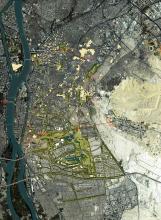On October 2, Dr. Jere Bacharach, professor emeritus of history at UW, gave a public lecture through the American Research Center in Egypt (ARCE) called, “Excavating Fustat, Cairo, Egypt.” The lecture introduced both the history of excavation at the site in Fustat as well as the findings of the excavations.
By Erin Kelleher, NELC MA student. Erin works on Near and Middle Eastern intellectual history
Professor Bacharach explained first that Fustat was continuously occupied from pre-Islamic times until around the late 12th century. From that time until 1881, no one lived in or excavated the area. In 1881, an Ottoman Turk name Ali Bahgat was the first to begin work there under the commission of a French committee intended salvage Islamic art and ruins. The next to work in Fustat were K.A.C. Creswell and Gaston Wilet, British and French archeologists respectively. No one worked on the site after 1921 until the American archeologist George Scanlon began working there in the 1960s. Following Scanlon, a Japanese archeologist named Muksuo Kawatoko did excavations from 1978-1985 and a French archeologist named Roland Pierre Gayraud did excavations between 1985 and 2005. The site has not been touched since 2005.
Among the findings of these various scholars was, most notably, houses that had elaborate underground sanitation systems and sophisticated fountains and garden spaces. This site was also home to the earliest known piece of glass lusterware in Islamic lands; unglazed water jugs with ornate filters, something that was common across the medieval Islamic world; Fatamid Era and Mamluk Era shards of pots attempting to imitate Chinese ceramics; beads; paper with block printing on it; textile fragments; and a wide variety of coins.
Although Professor Bacharach is pessimistic about the future of excavation in Fustat, the lecture provided a fascinating and informative introduction to both what has been found there and those who worked on the site.
